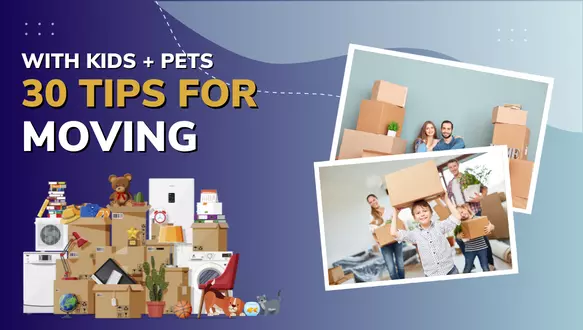
30 Tips for Moving with Kids or Pets
30 Tips for Moving with Kids or Pets Moving is stressful all on its own, but when you add in kids or pets (or both), it can feel downright impossible. But you can ensure the move is as low-stress for them, and you, as possible. Kids Consider the timing: Try not to layer a move on top of another stressful life event. Research the area: Help answer kids’ questions by learning about your new home. Communicate: Have age-appropriate conversations to help them prepare. Emphasize similarity: Give kids a good sense of what is NOT going to change. Plan: Figure out ways kids can participate — or get them out of the way. Offer choices: Paint color, furniture arrangement, hanging posters are all ways to give kids autonomy. Hire movers: This can really lower your stress levels and help you focus on your kids. Find an activity: Puzzles, books, or complicated new toys might be good ways to keep kids occupied if you can’t get them out of the house. Take advantage of night hours: Pack and remove items while kids are sleeping to streamline the process. Let kids help pack their things: This can help them feel like they have some control over the move. Help them say goodbye: If you’ll be leaving an area where you’ve lived for some time, help your kids prepare for this next step by saying goodbye. Prepare ‘overnight’ kits: A special stuffy or two, pajamas, a change of clothes, and so on will help kids transition more easily. Secure hotels in advance: Is there a pool? Will there be enough room for everyone? Make sure those questions are answered upfront if you’re on the road. Unpack their rooms first: Getting the kids’ bedrooms together can help them feel at home more quickly than you’d expect. Arrange furniture the same way: You’ll have plenty of time to move things around; for now, keeping things familiar can help kids adjust. Invest in surprises: Take kids somewhere fun or spring a gift on them to give them some positive feelings about their new home. Maintain routine: If your kids are used to an after-school snack, make sure it’s waiting for them — this isn’t the time to disrupt what’s soothing to them. Avoid disruption: Don’t start your kids in a new activity or push for a developmental stage right now. Keep calm: If you’re stressed out, your kids will be, too. Stay as cheerful and level-headed as you can during the move. Pets Acclimation: Get pets used to carriers, kennels, or cars Plan: Take pets to a day care, or keep their favorite room as intact as you can throughout the process. Hire movers: Professional packers and movers allow you to take your dog to the park while the move happens. Secure the animals: Don’t let any fur family members make a break for it while doors are open. Find an activity: A new, complicated toy can help occupy a pet during the move. Prepare ‘overnight’ kits: Plenty of food, a special toy or two, and familiar bedding or blankets can make a big difference to pets on the move. Secure hotels in advance: Will your pets be welcome and will there be enough room for them? Eliminate the chance that something could go wrong by booking ahead. Unpack a room for pets first: Scratching posts for cats, water and food, and toys — plus bedding and anything else that will help your pet feel at home — should be first off the truck. Arrange furniture the same way: Kids aren’t the only ones who benefit from a familiar arrangement. Pets can acclimate more quickly if you stick to your regular layout. Maintain routine: Walk the dog at the same time, stick to your feeding schedule, and do everything you can to keep things the same for pets, routine-wise. Keep calm: Your pets, of course, pick up on your mood. Try to make sure they’re only picking up happy, positive energy from you. Here is a FREE GUIDE TO MOVING WITH PETS, to keep on hand when it comes to the move!

23 Common Staging Mistakes Sellers Make
23 Common Staging Mistakes Sellers Make Staging a home isn't an exact science — it's more of an art, one that covers several rooms and flows throughout a home. The goal is to create a warm, welcoming space that will resonate with buyers. Here are the biggest mistakes you can make when staging your house for sale. An un-staged room: Unless you’re in a very strong seller’s market, you should consider light staging. Wall-to-wall furniture: Most of our homes contain too many items for staging to work well. Closets stuffed full of items: Hiding stuff instead of eliminating it won’t work when buyers peek inside closets. Cluttered surfaces: Give your home the best chance of hooking a buyer by clearing surfaces of clutter. Closed doors: Closed doors can give buyers a sense that you’re hiding something (and they’re just going to open them, anyway). Shabby carpet: Tired carpeting and peeling linoleum aren’t a good look in any home. Toys and books in the corner: How many is “too many” books or toys? You need to eliminate as much as you can. An (almost empty) staged room: Too little furniture is almost as bad as too much; a nearly empty room will look strange. Water stains on a wall corner: Ignoring critical improvements is just as bad as not staging at all. Patchy paint: Sprucing up your paint is easy and makes the room look pulled together; failing to do that is a mistake. Furniture too small for the room: You don’t have to fit your home’s scale exactly, but too-big or too-small items will make your rooms look off. Minimal/modernist décor: Clean, minimalist lines are all the rage, but these styles aren’t the most homelike. One aesthetic everywhere: Buyers who walk through might think this looks lovely, but they won’t see themselves living in it. Narrow, neutral color palettes: In rooms where everything is one color, nothing really stands out. A staged room Fake flowers: They’re easier to keep “alive,” but fake flowers and plants can make a house feel, well, fake. Family pictures on the wall: Buyers won’t be able to see themselves in a house full of your personal items. Collectible artwork: Museum showpieces can alienate buyers; best leave the collectible artwork stored away. Bare floors: Carpets or rugs can help provide structure and flow to rooms; forgetting them can make rooms feel adrift in a sea of house. Trying too hard: Over-staging makes sellers feel like they’re in a movie, not a real house. A staged room Cat litter box in the corner: Focusing only on sight means you’ll miss other ways that buyers are put off your house. Gorgeous picture window — with bookshelf in front of it: Don’t block views or architectural features with your furniture. Home exterior Patchy lawn: Don’t ignore curb appeal — your buyers sure won’t. Empty flowerpots: When you miss an opportunity to add plants or flowers, you’re missing out on the chance for your house to feel vibrant and alive. Here is a FREE photography preparation checklist to help you when it comes to preparing your home for professional photos! It will help to also avoid these mistakes when you are listing your home. When you are ready to sell your home - CONTACT ME and we can get to work!

18 Secrets No One Tells You About Buying A House
Here are 18 "secrets" or things you may have not been told when it comes to buying a house. You don't need to put 20% down These lenders offer low-down-payment or no-down-payment options: VA loans: 0% down* USDA loans: 0% down FHA loan: 3.5% down Some conventional loans: 3% down *Must be a veteran or veteran’s spouse ... But you do need to put any new credit line plans on hold Your mortgage rate and ability to secure a mortgage will depend on your credit score — ideally, at least 580, if not higher. You're not locked into one particular lender Talk to a few different mortgage brokers and ask them what their best deal is. Your monthly mortgage payment includes more than just the loan payback The monthly payment includes: Your loan principal — the amount of money you borrowed Your loan interest Taxes Insurance Private mortgage insurance (PMI) if you put less than 20% down ... So the mortgage amount online is not necessarily accurate Don’t just use the online calculators and think you know what you can afford — talk to an expert. School districts are important even without kids Homes in neighborhoods with good schools tend to appreciate in value more quickly, and those values stay more stable over time. You don't need to spend your entire preapproval amount Financial experts suggest that you spend no more than 30% of your household income on your mortgage. Don't overextend yourself! You'll look at homes out of your price range You will not be able to refrain from looking at homes just above your ideal price range. Look if you must, but don't let it influence your decision-making. You may get outbid, more than once Sellers often opt for cash buyers because the closing process is less cumbersome. Stay strong and have faith that your house is out there. Agents get paid on commission Your real estate agent will guide you through the homebuying process. When you reach the closing table and the house is yours, the seller cuts your agent a check. This is because agents are paid on commission — a percentage of the sale. Talk to a contractor before closing If the inspector finds issues, hire a contractor and go over the inspection report. Speaking of closing: Introducing closing costs! Closing costs can be picked up by the buyer, the seller, or both. They cost anywhere between 2% and 5% of the home’s purchase price and can include: Title search Title insurance Escrow or closing services Credit report fees Notary services Wire fees Courier and delivery fees Attorney fees Recording fees Local transfer taxes Home protection plans Natural hazard disclosure fees Home inspection fees Home appraisal fees FHA mortgage insurance premium fee Lender fees (application, underwriting, etc.) HOA fees Points purchase Survey fees Your mortgage will probably be sold to a servicer Most lenders sell mortgage loans to a servicing company, which will be the entity collecting your payments. (Credit unions are the exception.) Parking isn't always guaranteed If you live in a major metro area or have roommates or kids of driving age, you might struggle to find parking. You'll need to buy furniture Your new home is going to need some new items to fill it — just don’t buy a bunch of furniture on credit before your loan closes. You're on the hook for any home repairs Be aware that any systems that fail will be your responsibility to replace or fix, including: The roof The sewer line or septic tank Drains and plumbing The foundation The electric system The heating and cooling systems The water heater All major appliances Those nearby empty lots won't be empty forever You cannot take it for granted that the rolling (empty) hills around your brand-new home are going to remain empty. Stop in at your city or county offices periodically and ask what they know about any development plans or zoning for the area. It might take a while to feel like "home" It may take a few weeks or even months before you start settling in and feeling like a homeowner.
Categories
Recent Posts










